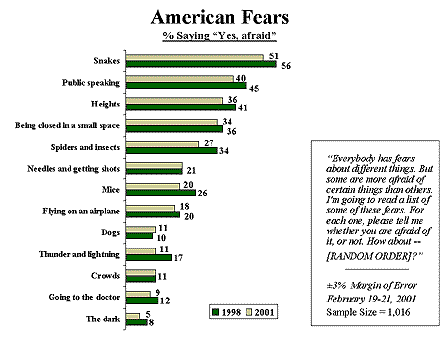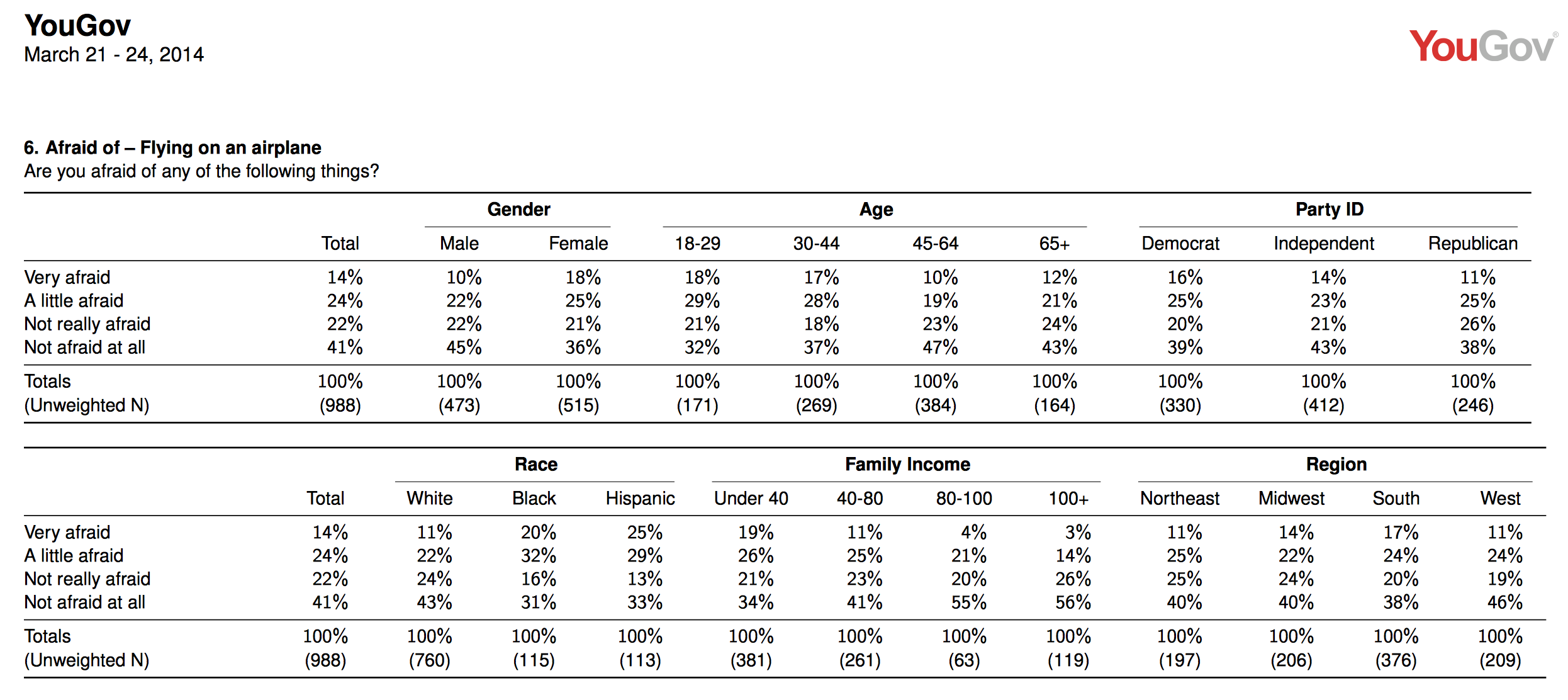A commonly quoted “statistic” is that 1-in-4 people are afraid to fly. Given that 78 percent of all statistics are made up, where does this “1-in-4” number come from?
Respectable research on Fear of Flying numbers is hard to come by and, in that context, it has been my suspicion that many of the touted numbers are simply regurgitations of the last serious study done on the topic from over 30 years ago. I therfore think it is worth a look at some of the research to see if the 1-in-4 figure stands up on it’s own. So here we go…
The most-cited source material comes from an article by Robert Dean and Kerry Whittaker, Fear of Flying: Impact on the U.S. Air Travel Industry, first published by Boeing in 1980 and then republished in the Journal of Travel Research in 1982. Sadly, access to this article now seems to be via paid subscription so it is not available for casual scrutiny. However, from abstracts and other publicly available quotes, it appears that Dean and Whittaker derived the following key results:
- Statistical sample: 5680 adult Americans, conducted in 1978
- Percentage of respondents “afraid to fly”: 18%
- Percentage of respondents “anxious about flying”: 12%
- Therefore, total number of Americans “afraid to fly”: 25,000,000 (based on 1978 US adult population)
- Ratio of those “afraid to fly” to general US adult population: 1-in-6
There is a big difference between 1-in-4 and 1-in-6, so what gives?
Most likely the 1-in-4 figure comes from grouping the “afraid to fly” and “anxious about flying” groups together (18% plus 12% equals 30%… comfortably “1-in-4“, but also arguably “almost 1-in-3“… another figure you will sometimes see quoted.)
Some other surveys have been done that, while not specifically targeted at Fear of Flying, do support the findings of the 1980 Dean research. For example, in 1998 and 2001 Gallup surveys about general fears found Fear of Flying to affect approximately 1-in-5 Americans to some degree. Specifically, 18% of US respondents identified being affected by Fear of Flying in 2001, with the results further broken down by gender: male(14%), women (22%). (Note that this survey of 1016 adult Americans was conducted before September 11, 2001. Also, that survey did not differentiate between the degree of fear and so may only be representative of a high level of fear rather than including moderate anxiety.)
YouGov conducts online surveys and they have conducted numerous general Fear surveys in the UK and US. Here is some data from their 2014 survey where respondents were asked about their fears. It is worth noting that the YouGov’s figures for the percentage of respondents who identified some level of fear of flying differ markedly for the UK (24%, approximately 1-in-4) and the US (38%, more than 1-in-3)…
For those that want the hard data rather than a pretty graph, visit the yougov.co.uk for details on how their surveys were conducted. Here are the specific Fear of Flying results for the US in 2014:
and for the UK (total 24%, with gender breakdown of: men 19%, women 29%):
British Airways reportedly commissioned YouGov to do a a Fear of Flying survey in the United Arab Emirates in early 2014 to see if it was worth their while running a Fear of Flying course in Dubai (which they subsequently did, and they intend running further courses in UAE in the future).
A recent survey by the UK’s flag carrier shows that one in four UAE residents have a fear of flying. Of those respondents, 42 percent feel that the fear is detrimental to their quality of life. BA teamed with YouGov to poll 1,000 fliers across the Gulf nation.
So where does all of that research leave us? Is the 1-in-4 figure so often touted reasonable? Certainly the available research, while patchy and some of it quite old, does support a Fear of Flying figure in the 18-39% range (depending on location, gender and year). This corresponds roughly to 1-in-6 through 1-in-3. It is important, however, to differentiate between a phobia level of fear (that might completely prevent a person from boarding an aircraft) and a moderate level of anxiety (which might not prevent a flight but will make it unpleasant, and may act as a deterrent to all but essential flights).
Sometimes these statistics are used disingenuously. For example, a statement like “1-in-4 people on any flight are afraid” is unlikely to be correct as the sample group has already been filtered — many people with a phobic level of Fear of Flying will not be aboard, having decided to take the more dangerous option of driving their car instead!.
In the context of Fear of Flying having some effect however, be it a phobia or simply significant discomfort, the 1-in-4 figure is reasonable.
The 1980 article by Dean and Whittaker was the first, and possibly only, well known piece of serious research into the economic impact of Fear of Flying. They postulated that Fear of Flying had a negative impact of US airline industry of $1.6 billion dollars per year… in 1978 dollars! What that figure might be today is anybody’s guess but it is clear that some airlines (particularly in the UK) see considerable financial potential in helping fearful flyers and are putting great efforts into running or supporting Fear of Flying courses.
With regard to surveys about Fear of Flying we may suppose that some variability exists depending upon when the survey was taken, and the proximity to significant newsworthy accidents or incidents. For example, the events of September 11, 2001 had a large effect on Fear of Flying levels and, one may presume, the mystery and pervasive news coverage of Malaysian MH370 may likewise produce a spike in results.
At the end of the day, however, whether the Fear of Flying numbers are 1-in-4 or only 1-in-6 doesn’t really matter — it is still a lot of people and if you are unlucky enough to be one of it’s sufferers then your personal sample size is 100% affected.
Tags: fear of flying, fear of flying statistics







At last you are here. Be bold. Sieze the moment. Be the first to take the opportunity to post a comment here.
We have beeen waiting for you to arrive here to provide your feedback. Now that you are here, go ahead and post a quick note. We would appreciate it.